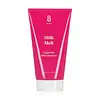What's inside
What's inside
 Key Ingredients
Key Ingredients

No key ingredients
 Benefits
Benefits

 Concerns
Concerns

 Ingredients Side-by-side
Ingredients Side-by-side

Water
Skin ConditioningCaprylic/Capric Triglyceride
MaskingGlycerin
HumectantSodium Laurylglucosides Hydroxypropylsulfonate
CleansingColloidal Oatmeal
AbsorbentMaltooligosyl Glucoside
Skin ConditioningSodium Cocoamphoacetate
CleansingHydrogenated Starch Hydrolysate
HumectantAvena Sativa Kernel Oil
Skin ConditioningLauryl Glucoside
CleansingXanthan Gum
EmulsifyingPropanediol
SolventSodium Cocoyl Glutamate
CleansingSodium Lauryl Glucose Carboxylate
CleansingBenzyl Alcohol
PerfumingLactic Acid
BufferingSodium Chloride
MaskingSodium Cocoyl Hydrolyzed Oat Protein
Skin ConditioningCaprylic Acid
CleansingXylitol
HumectantTetrasodium Glutamate Diacetate
Tocopherol
AntioxidantCocos Nucifera Fruit Extract
EmollientLeuconostoc/Radish Root Ferment Filtrate
AntimicrobialLactobacillus Ferment
Skin ConditioningAgastache Mexicana Flower/Leaf/Stem Extract
Skin ConditioningButylene Glycol
HumectantWater, Caprylic/Capric Triglyceride, Glycerin, Sodium Laurylglucosides Hydroxypropylsulfonate, Colloidal Oatmeal, Maltooligosyl Glucoside, Sodium Cocoamphoacetate, Hydrogenated Starch Hydrolysate, Avena Sativa Kernel Oil, Lauryl Glucoside, Xanthan Gum, Propanediol, Sodium Cocoyl Glutamate, Sodium Lauryl Glucose Carboxylate, Benzyl Alcohol, Lactic Acid, Sodium Chloride, Sodium Cocoyl Hydrolyzed Oat Protein, Caprylic Acid, Xylitol, Tetrasodium Glutamate Diacetate, Tocopherol, Cocos Nucifera Fruit Extract, Leuconostoc/Radish Root Ferment Filtrate, Lactobacillus Ferment, Agastache Mexicana Flower/Leaf/Stem Extract, Butylene Glycol
Water
Skin ConditioningStearic Acid
CleansingGlycerin
HumectantLauric Acid
CleansingPotassium Hydroxide
BufferingMyristic Acid
CleansingGlyceryl Stearate
EmollientPEG-100 Stearate
Cocamidopropyl Betaine
CleansingPEG-8
HumectantPolyquaternium-7
Polysorbate 20
EmulsifyingHydroxyethylcellulose
Emulsion StabilisingSodium Chloride
MaskingBambusa Vulgaris Leaf/Stem Extract
HumectantSaponaria Officinalis Leaf Extract
AntimicrobialButylene Glycol
Humectant1,2-Hexanediol
Skin ConditioningCI 19140
Cosmetic ColorantCI 42090
Cosmetic ColorantPhenoxyethanol
PreservativeParfum
MaskingWater, Stearic Acid, Glycerin, Lauric Acid, Potassium Hydroxide, Myristic Acid, Glyceryl Stearate, PEG-100 Stearate, Cocamidopropyl Betaine, PEG-8, Polyquaternium-7, Polysorbate 20, Hydroxyethylcellulose, Sodium Chloride, Bambusa Vulgaris Leaf/Stem Extract, Saponaria Officinalis Leaf Extract, Butylene Glycol, 1,2-Hexanediol, CI 19140, CI 42090, Phenoxyethanol, Parfum
Ingredients Explained
These ingredients are found in both products.
Ingredients higher up in an ingredient list are typically present in a larger amount.
Butylene Glycol (or BG) is used within cosmetic products for a few different reasons:
Overall, Butylene Glycol is a safe and well-rounded ingredient that works well with other ingredients.
Though this ingredient works well with most skin types, some people with sensitive skin may experience a reaction such as allergic rashes, closed comedones, or itchiness.
Learn more about Butylene GlycolGlycerin is already naturally found in your skin. It helps moisturize and protect your skin.
A study from 2016 found glycerin to be more effective as a humectant than AHAs and hyaluronic acid.
As a humectant, it helps the skin stay hydrated by pulling moisture to your skin. The low molecular weight of glycerin allows it to pull moisture into the deeper layers of your skin.
Hydrated skin improves your skin barrier; Your skin barrier helps protect against irritants and bacteria.
Glycerin has also been found to have antimicrobial and antiviral properties. Due to these properties, glycerin is often used in wound and burn treatments.
In cosmetics, glycerin is usually derived from plants such as soybean or palm. However, it can also be sourced from animals, such as tallow or animal fat.
This ingredient is organic, colorless, odorless, and non-toxic.
Glycerin is the name for this ingredient in American English. British English uses Glycerol/Glycerine.
Learn more about GlycerinChances are, you eat sodium chloride every day. Sodium Chloride is also known as table salt.
This ingredient has many purposes in skincare: thickener, emulsifier, and exfoliator.
You'll most likely find this ingredient in cleansers where it is used to create a gel-like texture. As an emulsifier, it also prevents ingredients from separating.
There is much debate on whether this ingredient is comedogenic. The short answer - comedogenic ratings don't tell the whole story. Learn more about comegodenic ratings here.
The concensus about this ingredient causing acne seems to be divided. Research is needed to understand if this ingredient does cause acne.
Scrubs may use salt as the primary exfoliating ingredient.
Learn more about Sodium ChlorideWater. It's the most common cosmetic ingredient of all. You'll usually see it at the top of ingredient lists, meaning that it makes up the largest part of the product.
So why is it so popular? Water most often acts as a solvent - this means that it helps dissolve other ingredients into the formulation.
You'll also recognize water as that liquid we all need to stay alive. If you see this, drink a glass of water. Stay hydrated!
Learn more about Water